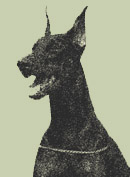


| |European Standard| |
European vs. American Dobermans | ||||
|
||||
Why do we breed European Dobermans?As they say: “Beauty is in the eyes of the beholder!” Maybe so, but personally I made my choice long ago, when I purchased my first European Doberman 10 years ago. After owning this great dog, I could not settle for less. I love European type dogs: muscular, powerful, with beautiful, strong and long heads, with that proud dobe’s expression.
The American type is a lighter dog, with a weaker bone-structure. The American standard says the following about the height at the withers:
“dogs 26 (66 cms) to 28 inches (71.1 cms) ideal about 27 1/2 inches; bitches 24 (61cms) to 26 inches (66 cms), ideal about 25 1/2 inches…
DISQUALIFICATIONS: Overshot more than 3/16 of an inch (0.5 cms).” I am also not a great fan of the head type of the American Dobermans, for my taste it is too narrow with weak jaws. If you still have doubts, look at the best of what Europe has to offer at page. I promise you, you will want to have a European bred Doberman.
Another consideration is your future dog temperament. The Doberman was originally bred as a guardian and personal protector. As it was put by Ray Carlisle: The Dobermann was, indeed, bred to work. Europe still recognizes this. European bred dog will, in general, perform better than the American bred one in protection and tracking fields. This is due to the ZTP requirement for breeding in most European countries. America has bred down the working edge of the dog and it HAS become more of a pet/companion dog. They are still good watchdogs and will bark at strangers, etc., but they won’t make as good of Schutzhund or protection dog as their European counterpart. By the way a protection dog does not mean the dog that attacks. In fact a dog with unprovoked aggression is not good material for Schutzhund or IPO training and won’t be able to pass the ZTP requirement. A truly proper temperament will have the mind (intelligence) to be stable around children and non-threatening strangers, but will also be protective when danger arises. On the other end of the spectrum is a dog that is skittish, shy and frightful. Unfortunately many American lines have produced the dogs with these undesirable characteristics. Another consideration is health of the breed. The inbreeding of the Doberman and continuous use of a few popular sires paired with the hereditary problems of certain dogs resulted in an increased hereditary problems in North American Doberman population. Dr. Reinhard Haberzettl mentions 5 hereditary defects of the breed (DCM or cardio, Gastric Volvulus (bloat), Hypothyroidism, Von-Willebrand disease (vWD), Wobbler syndrome). He further mentions that the population of German and European dogs is currently similarly highly burdened with 2 hereditary problems (such as DCM - Dialated cardiomyopathy and Gastric Vovulus (bloat) )as a consequence of the same bad breeding practices. The bottom line for me is that for pet or performance, go Euro.
|
||||